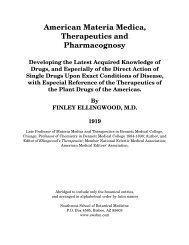SCARLET FEVER. Synonyms.—Scarlatina; Scarlet Rash. Definition ...
SCARLET FEVER. Synonyms.—Scarlatina; Scarlet Rash. Definition ...
SCARLET FEVER. Synonyms.—Scarlatina; Scarlet Rash. Definition ...
Create successful ePaper yourself
Turn your PDF publications into a flip-book with our unique Google optimized e-Paper software.
a form or variety of tuberculosis.<br />
Etiology.—Anything that tends to lower the vitality of the lymph<br />
tissue is a predisposing cause. Poverty and environment are fruitful<br />
causal conditions, and tuberculosis of the lymph glands is much more<br />
common among the extreme poor than the well-to-do.<br />
Age.—While this form may occur at any age, it is exceedingly rare after<br />
middle life, the greatest number of cases occurring among children.<br />
Race.—The negro is peculiarly susceptible.<br />
Catarrhal conditions of the mucous membranes render the patient far<br />
more susceptible than those otherwise affected. The germs lodge upon<br />
the mucous membranes in naso-pharyngitis, and readily find their way<br />
into the lymph channels, and are carried to the near-by glands.<br />
Tonsillitis, for the same reason, may be the forerunner of tubercular<br />
adenitis.<br />
Eczema may furnish a rich soil for the reception of the germ, which in<br />
turn finds its way into the lymph current, and the glands receive the<br />
force of the poison.<br />
Clinical Forms.—The various phases of this variety may be grouped<br />
under two heads: generalized tubercular lymphadenitis, and local<br />
tubercular adenitis.<br />
Generalised Tubercular Lymphadenitis.—This form may involve the<br />
lymphatic system at large, while the viscera may escape. The cervical<br />
lymphatics are more frequently the seat of infection, though any group<br />
may be the source, and the general infection which follows might be<br />
regarded as secondary. Usually its course is chronic, though it may have<br />
an acute course.<br />
Symptoms.—Although there is no evidence of lung trouble, the patient<br />
is going into a decline. There is loss of flesh and strength, the appetite is<br />
capricious, the tongue furred, and secretions are deranged. A fever,<br />
irregular in character, is a marked feature. Emaciation becomes marked,<br />
while the cervical and axillary glands become swollen, with a tendency<br />
to suppuration. In the general appearance there is a great resemblance<br />
to Hodgkin's disease.<br />
The Eclectic Practice of Medicine - PART I - Infectious Diseases - Page 188

















